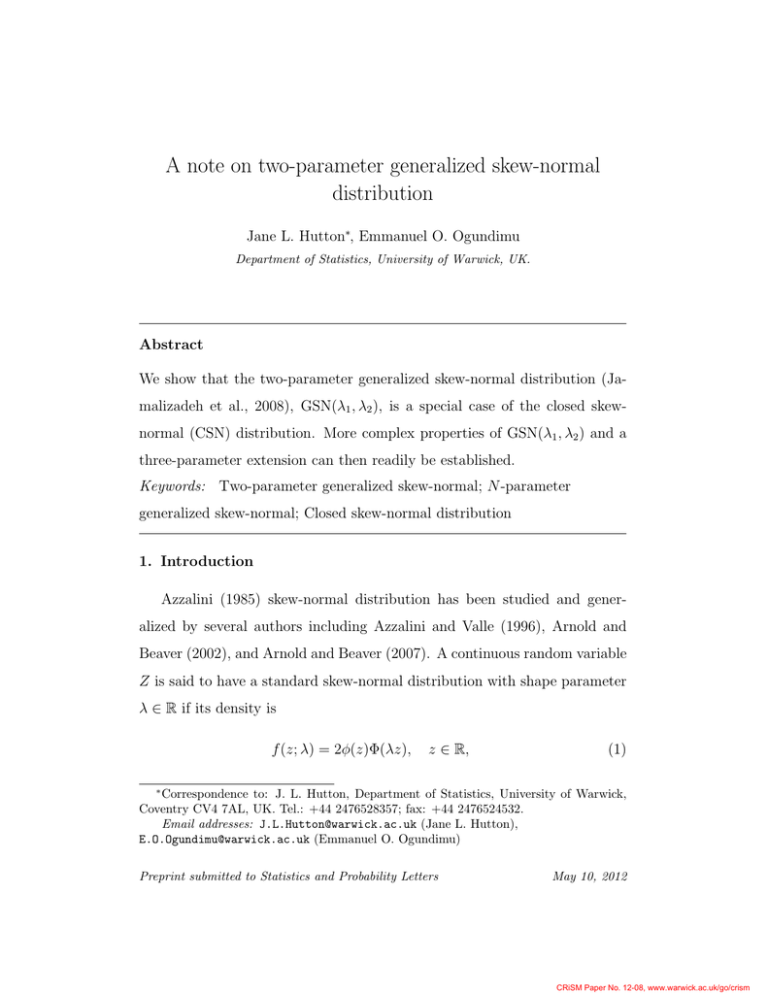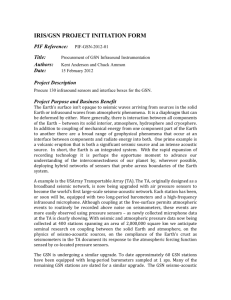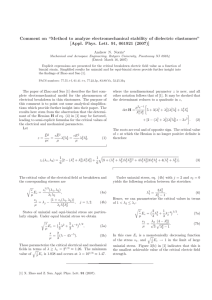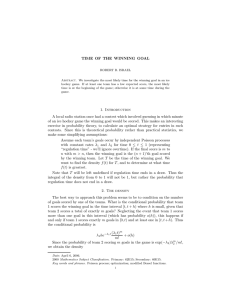A note on two-parameter generalized skew-normal distribution
advertisement

A note on two-parameter generalized skew-normal distribution Jane L. Hutton∗, Emmanuel O. Ogundimu Department of Statistics, University of Warwick, UK. Abstract We show that the two-parameter generalized skew-normal distribution (Jamalizadeh et al., 2008), GSN(λ1 , λ2 ), is a special case of the closed skewnormal (CSN) distribution. More complex properties of GSN(λ1 , λ2 ) and a three-parameter extension can then readily be established. Keywords: Two-parameter generalized skew-normal; N -parameter generalized skew-normal; Closed skew-normal distribution 1. Introduction Azzalini (1985) skew-normal distribution has been studied and generalized by several authors including Azzalini and Valle (1996), Arnold and Beaver (2002), and Arnold and Beaver (2007). A continuous random variable Z is said to have a standard skew-normal distribution with shape parameter λ ∈ R if its density is f (z; λ) = 2φ(z)Φ(λz), z ∈ R, (1) ∗ Correspondence to: J. L. Hutton, Department of Statistics, University of Warwick, Coventry CV4 7AL, UK. Tel.: +44 2476528357; fax: +44 2476524532. Email addresses: J.L.Hutton@warwick.ac.uk (Jane L. Hutton), E.O.Ogundimu@warwick.ac.uk (Emmanuel O. Ogundimu) Preprint submitted to Statistics and Probability Letters May 10, 2012 CRiSM Paper No. 12-08, www.warwick.ac.uk/go/crism where φ and Φ denote the standard normal density and corresponding distribution function respectively. A generalization of the skew-normal distribution is the two-parameter generalized skew-normal distribution (denoted by GSN(λ1 , λ2 )) given by Jamalizadeh et al. (2008). Its pdf was given as . −1 f (z; λ1 , λ2 ) = 2πφ(z)Φ(λ1 z)Φ(λ2 z) cos −λ1 λ2 p p , 1 + λ21 1 + λ22 z ∈ R. (2) Jamalizadeh et al. (2008) established some properties of the distribution. We show that this two-parameter generalized skew-normal distribution is a special case of the wider class of the closed skew-normal (CSN) distribution (Gonzalez-Farias et al., 2004). The properties of the CSN distribution are inherited by the GSN(λ1 , λ2 ) distribution. The CSN formulation provides an easy method for adding independent random variables, which cannot be readily obtained using the form given in (2), and a straightforward approach to the construction of a wider class of generalized skew-normal distributions. The remainder of this note is organized as follows. In section 2, we show the link between GSN(λ1 , λ2 ) and the CSN distribution, and derive the moment generating function of GSN(λ1 , λ2 ). Further properties, including addition of independent random variables is given in section 3. In section 4, we construct a three-parameter generalized skew-normal distribution (GSN(λ1 , λ2 , λ3 )) and derive its moment generating function. A numerical example is used in this section to illustrate the practical usefulness of GSN(λ1 , λ2 , λ3 ). 2 CRiSM Paper No. 12-08, www.warwick.ac.uk/go/crism 2. Generalized skew-normal distirbution A more general version of (2) was given in Jamalizadeh et al. (2011) as . −(ρ + λ λ ) p1 2 . f (z; λ1 , λ2 , ρ) = 2πφ(z)Φ2 (λ1 z, λ2 z; ρ) cos−1 p 2 1 + λ1 1 + λ22 (3) If ρ = 0 in (3), the pdf in (2) is recovered. Now, we can write (2) as −λ1 λ2 p , 1 + λ21 1 + λ22 (4) . −1 p f (z; λ1 , λ2 ) = 2πφ(z)Φ2 ((λ1 , λ2 ) z; (0, 0) , I2 ) cos 0 0 where I2 is a 2×2 identity matrix. Equation (4) has a closed skew-normal form defined below. Definition 1 : Consider p ≥ 1, q ≥ 1, µ ∈ Rp , ν ∈ Rq , D an arbitrary q × p matrix, Σ and ∆ positive definite matrices of dimensions p × p and q × q, respectively. Then the probability density function (pdf ) of the CSN distribution is given by: fp,q (y) = Cφp (y; µ, Σ)Φq (D(y − µ); ν, ∆), y ∈ Rp , (5) with: C −1 = Φq (0; ν, ∆ + DΣD0 ), (6) where φp (.; η, Ψ), Φp (.; η, Ψ) are the pdf and cdf of a p-dimensional normal distribution with mean η ∈ Rp and p × p covariance matrix Ψ. We write Y ∼ CSNp,q (µ, Σ, D, ν, ∆), if y ∈ Rp is distributed as CSN distribution with parameters q, µ, D, Σ, ν, ∆ (Gonzalez-Farias et al., 2004). To see that (4) has a CSN density, define µ = 0, Σ = 1, D = (λ1 , λ2 )0 , ν = (0, 0)0 and ∆ = I2 , then we can write equation (6) as 3 CRiSM Paper No. 12-08, www.warwick.ac.uk/go/crism q .q 2 2 Φ2 (0; ν, ∆ + DΣD ) = Φ2 0; 0, λ1 λ2 1 + λ1 1 + λ2 , 0 (7) using the standard reparametrization. To complete the proof, we make use of the following result: 1 ρ12 , then Φ2 (0; R) = 1/2 − 1/2π cos−1 ρ12 . Lemma 1 : If R = ρ12 1 Hence (7), becomes , −λ λ 1 2 p cos−1 p 2π (8) 1 + λ21 1 + λ22 Thus (4), and hence (2) can be written as . 0 0 f (z; λ1 , λ2 ) = φ(z)Φ2 (λ1 , λ2 ) z; (0, 0) , I2 Φ2 0; 0, p λ1 λ2 p , 1 + λ21 1 + λ22 (9) and we write, Z ∼ CSN1,2 (0, 1, D, ν, I2 ), where D, ν and I2 are as defined above. We henceforth put −1 2π cos −λ1 λ2 p p 1 + λ21 1 + λ22 −1 q .q 2 2 1 + λ1 1 + λ2 = K(λ1 , λ2 )−1 = Φ2 0; λ1 λ2 The moment generating function (mgf) of the CSN density given in (5) is MY (t) = Φq (DΣt; ν, ∆ + DΣD0 ) t0 µ+ 1 t0 Σt 2 e , Φq (0; ν, ∆ + DΣD0 ) t ∈ Rp . (10) The mgf of a special case of CSN distribution given by (4) (equivalently (2)) becomes t2 /2 Mz (t) = K(λ1 , λ2 )e Φ2 λ1 λ2 p p ,p ;p , 1 + λ21 1 + λ22 1 + λ21 1 + λ22 λ1 t λ2 t (11) 4 CRiSM Paper No. 12-08, www.warwick.ac.uk/go/crism which is equivalent to equation (9) given in Jamalizadeh et al. (2008). A formula for computing the mean and the variance from the mgf of CSN distribution was given in Dominguez-Molina et al. (2003). 3. Further properties of GSN(λ1 , λ2 ) Jamalizadeh et al. (2008) gave some simple properties of GSN(λ1 , λ2 ). These properties can readily be derived if we use the CSN representation given in (9). For instance, GSN(λ, 0) = GSN(0, λ) = SN(λ) can be shown if either λ1 or λ2 = 0 in (9), as Φ(0) = 1/2 and Φ2 (0) = 1/4. Another property deals with scalar multiplication of the two parameter generalized skew-normal distribution. If Zλ1 ,λ2 ∼ GSN(λ1 , λ2 ), then −Zλ1 ,λ2 ∼ GSN(−λ1 , −λ2 ). This property can be deduced from scalar multiplication of CSN distribution, i.e. if Y ∼ CSNp,q (µ, Σ, D, ν, ∆), then for any c ∈ R cY ∼ CSNp,q (cµ, Σc2 , Dc−1 , ν, ∆). However, there are properties of GSN(λ1 , λ2 ) that cannot be derived easily using the form given in Jamalizadeh et al. (2008). These include sum of independent realizations of random variables from the distribution and generation of random numbers from the distribution. These properties and many more are easily derived under the CSN distribution. For instance, the addition of an independent random variable from GSN(λ1 , λ2 ) and a normal N (0, 1) random variable is still in the two-parameter generalized skew-normal distribution as the following theorem shows. Theorem : Let Y ∼ CSNp,q (µ, Σ, D, ν, ∆), with parameters as defined in (5). Let also X ∼ N (µx , Σx ), Σx > 0 be independent of Y, then 5 CRiSM Paper No. 12-08, www.warwick.ac.uk/go/crism Y + X ∼ CSNp,q µ + µx , Σ + Σx , DΣ(Σ + Σx )−1 , ν, ∆ + (D(I − Σ(Σ + Σx )−1 ))ΣD0 . If we apply the theorem to Zλ1 ,λ2 ∼ GSN(λ1 , λ2 ) and X ∼ N (0, 1), we have 2 √ √ 1 + λ1 /2 λ1 λ2 /2 1 0 √ Zλ1 ,λ2 +X ∼ CSN1,2 0, 1, (λ1 / 2, λ2 / 2) , 0, , 2 λ1 λ2 /2 1 + λ22 /2 which is a two-parameter generalized skew-normal distribution with param √ √ eters λ1 / 2, λ2 / 2 . This theorem is a special case of the general method of adding independent random variables from the CSN distribution (see Gonzalez-Farias et al. (2004)). 4. A three-parameter generalized skew-normal distribution (GSN(λ1 , λ2 , λ3 )) Using the definition of CSN distribution and the link between the twoparameter generalized skew-normal distribution discussed in section 2, one can easily define a three-parameter generalized skew-normal distribution. Definition 2 : A random variable Zλ1 ,λ2 ,λ3 is said to have a three-parameter generalized skew-normal distribution if its pdf can be written as . f (z; λ1 , λ2 , λ3 ) = φ(z)Φ3 ((λ1 , λ2 , λ3 )0 z; 0, I3 ) Φ3 (0; ρ12 , ρ13 , ρ23 ), (12) .p q 2 where ρij = λi λj 1 + λi 1 + λ2j , i 6= j, i, j = 1, 2, 3, and I3 is a 3×3 identity matrix. We write Z ∼ CSN1,3 (0, 1, D = (λ1 , λ2 , λ3 )0 , ν = (0, 0, 0)0 , I3 ). Since the pdf given by (12) is in a CSN form, it is clearly a proper pdf. 6 CRiSM Paper No. 12-08, www.warwick.ac.uk/go/crism The form given by Jamalizadeh et al. (2008), using an extension of Lemma 1 allows us to avoid theevaluation of three dimensional integral in (12). 1 ρ12 ρ13 Lemma 2 : If R = ρ12 1 ρ23 , then ρ13 ρ23 1 . Φ3 (0; R) = 2π − cos−1 (ρ12 ) − cos−1 (ρ13 ) − cos−1 (ρ23 4π. Thus equation (12) can be written as . −1 −1 −1 4πφ(z)Φ(λ1 z)Φ(λ2 z)Φ(λ3 z) 2π − cos (ρ12 ) − cos (ρ13 ) − cos (ρ23 ) , and we write Zλ1 ,λ2 ,λ3 ∼ GSN (λ1 , λ2 , λ3 ). The normalizing constant is now denoted n o−1 4π 2π − cos−1 (ρ12 ) − cos−1 (ρ13 ) − cos−1 (ρ23 ) = K(λ1 , λ2 , λ3 )−1 . 4.1. Basic properties of GSN(λ1 , λ2 , λ3 ) Using the properties of CSN distribution, simple properties of GSN(λ1 , λ2 , λ3 ) distribution can be obtained: 1. GSN(λ1 , λ2 , 0) = GSN(λ1 , 0, λ2 ) = GSN(0, λ1 , λ2 ) = GSN(λ1 , λ2 ), 2. GSN(λ, 0, 0) = GSN(0, λ, 0) = GSN(0, 0, λ) = SN(λ), 3. GSN(0,0,0) = N(0,1), and 4. If Z ∼ GSN(λ1 , λ2 , λ3 ), then −Z ∼ GSN(−λ1 , −λ2 , −λ3 ). The distribution function of Z ∼ GSN(λ1 , λ2 , λ3 ) is 7 CRiSM Paper No. 12-08, www.warwick.ac.uk/go/crism 1 −λ1 −λ2 −λ3 0 Z 0 0 −λ1 1 + λ21 λ1 λ2 λ1 λ3 . K(λ1 , λ2 , λ3 )Φ4 ; , 2 0 0 −λ2 λ1 λ2 1 + λ2 λ2 λ3 −λ3 λ1 λ3 λ2 λ3 1 + λ23 0 0 A comparison of the density GSN(0, 0, 0) with GSN(λ, 0, −λ) shows that the latter is also symmetric but with kurtosis different from the Normal distribution. 4.2. Moment generating function of GSN(λ1 , λ2 , λ3 ) The moment generating function of GSN(λ1 , λ2 , λ3 ) can be derived easily if we use its link with the moment generating function of CSN distribution given in (10), and is t2 /2 Mz (t) = K(λ1 , λ2 , λ3 )e Φ3 p λ1 t 1 + λ21 ,p λ2 t 1 + λ22 ,p λ3 t 1 + λ23 ; ρ12 , ρ13 , ρ23 . The mean and the variance of the three-parameter generalized skew-normal distribution are respectively, ( λ1 −λ2 λ3 K(λ1 , λ2 , λ3 ) −1 p p cos E(Zλ1 ,λ2 ,λ3 ) = (2π)3/2 (1 + λ21 + λ22 )(1 + λ21 + λ23 ) 1 + λ21 λ2 −λ1 λ3 −1 p +p cos (1 + λ22 + λ23 )(1 + λ21 + λ22 ) 1 + λ22 ) λ3 −λ λ 1 2 +p cos−1 p , 2 2 2 (1 + λ1 + λ3 )(1 + λ22 + λ23 ) 1 + λ3 8 CRiSM Paper No. 12-08, www.warwick.ac.uk/go/crism K(λ1 , λ2 , λ3 ) Var(Zλ1 ,λ2 ,λ3 ) = 1 + 4π ( 1 1 p + 1 + λ21 + λ22 1 + λ21 1 + λ22 1 λ1 λ3 1 +p + 1 + λ21 + λ23 1 + λ21 1 + λ23 ) λ2 λ3 1 1 +p + 1 + λ22 + λ23 1 + λ22 1 + λ23 2 − E(Zλ1 ,λ2 ,λ3 ) . λ1 λ2 Table 1: MLEs for the heights of Australian athletes data under four sub-models of GSN(µ, σ 2 , λ1 , λ2 , λ3 ) N (µ, σ 2 ) SN(µ, σ 2 , λ) GSN(µ, σ 2 , λ1 , λ2 ) GSN(µ, σ 2 , λ1 , λ2 , λ3 ) µ 174.594 182.270 185.127 187.334 σ2 67.255 126.132 141.522 152.614 λ1 - -1.717 -1.415 -1.275 λ2 - - -1.415 -1.275 λ3 - - - -1.275 -352.318 -350.303 -350.273 -350.271 Log-likelihood 4.3. Numerical Example To fit the three-parameter skew-normal distribution to data, one can introduce the affine transformation Y = µ+σZλ1 ,λ2 ,λ3 ∼ GSN(µ, σ 2 , λ1 , λ2 , λ3 ). The density becomes 9 CRiSM Paper No. 12-08, www.warwick.ac.uk/go/crism y−µ K(λ1 , λ2 , λ3 ) φ f (y; µ, σ , λ1 , λ2 , λ3 ) = σ σ λ1 (y − µ) λ2 (y − µ) λ3 (y − µ) ×Φ Φ Φ , σ σ σ 2 y ∈ R. To illustrate the use of the model, we consider data on the heights (in centimeters) of 100 female Australian athletes, used by Jamalizadeh et al. (2008). Table 1 shows the maximum likelihood estimates of four sub-models of GSN(µ, σ 2 , λ1 , λ2 , λ3 ) to the Australian athletes data. Note that Jamalizadeh et al. (2008) provided centered parameter estimates for the skew-normal model fitted to this data. This made it appear that the skewness parameter is almost zero (λ = 0.004) and the data is far from being skew. However, the correct parameter from the direct parametrization of the skew-normal model shows the data are skew. The three skew-normal models have essentially the same maximum log-likelihoods, and have three free parameters. The density function shows that the three skewness parameters are separate but indistinguishable. They are automatically constrained to take the same value in the optimization process if the initial values are chosen well. For symmetric data with light or heavy tails, the construct with λ3 = −λ1 , λ2 = 0 might be useful. 10 CRiSM Paper No. 12-08, www.warwick.ac.uk/go/crism Arnold, B. C., Beaver, R. J., 2002. Skewed multivariate models related to hidden truncation and/or selective reporting. Test 11, 7–54. Arnold, B. C., Beaver, R. J., 2007. Skewing Around: Relationships among Classes of Skewed Distributions. Methodol Comput Appl Probab 9, 153– 162. Azzalini, A., 1985. A class of distributions which includes the normal ones. Scandinavian Journal of Statistics 12, 171–178. Azzalini, A., Valle, A. D., 1996. The multivariate skew-normal distribution. Biometrika 83, 715–726. Dominguez-Molina, J., Graciela Gonzalez-Farias, Gupta, A. K., 2003. The multivariate closed skew-normal distribution. Department of Mathematics and Statistics, Bowling Green State University Technical Report 03 − 12. Gonzalez-Farias, G., Dominguez-Molina, J. A., Gupta, A. K., 2004. The closed skew-normal. In: Genton, M. G. (Ed.), Skew-Elliptical Distributions and Their Applications: A Journey Beyond Normality. Chapman & Hall, CRC, Boca Raton, Florida, pp. 25–42. Jamalizadeh, A., Arabpour, A., Balakrishnan, N., 2011. A generalized skew two-piece skew-normal distribution. Statistics and Probability Letters 52, 431–446. Jamalizadeh, A., Behboodian, J., Balakrishnan, N., 2008. A two-parameter generalized skew-normal distribution. Statistics and Probability Letters 78, 1722–1728. 11 CRiSM Paper No. 12-08, www.warwick.ac.uk/go/crism




